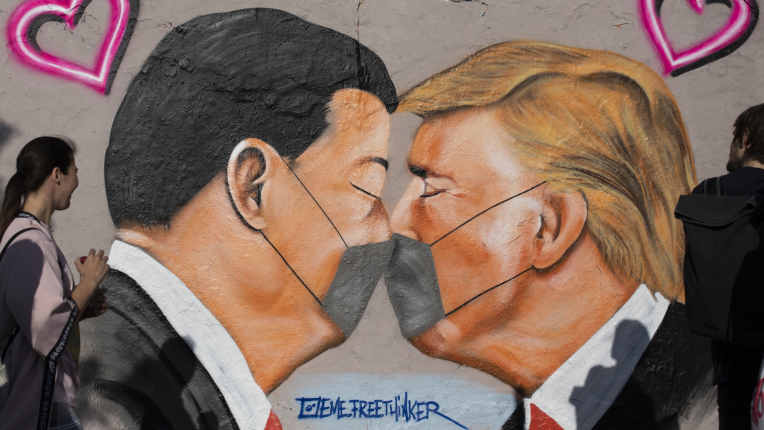Hong Kong another sideshow in a larger China drama with no final act
by Jennifer HewettBetween anti-China tweets, Donald Trump is playing golf again. Pro-democracy demonstrators are back protesting on the streets of Hong Kong. The Morrison government is still insisting Australia’s relationship with its most important trading partner remains strong.
But there’s no return to politics as usual, globally or domestically. Well beyond the economic and social destruction wrought by COVID-19, the tectonic power plates between the US and China have shifted even further and faster over the last few months. No V-shaped or U-shaped recovery from that confrontation is possible, whether or not Trump gets re-elected in November. It’s more how to adapt to the dangerous fissures opening up.
Australia, for all the particular disputes over Huawei, or barley tariffs or Canberra's determination to distance itself from the more erratic US moves, is inevitably enmeshed in that broader, longer struggle for strategic supremacy. This covers all aspects of US-China rivalry – economic, commercial, technological, ideological and cultural as well as shows of military strength.
Gregory Copley, president of the Washington-based The International Strategic Studies Association, says this has become an overt war of a new type where the West has not written the rules of engagement and has only just begun to acknowledge the changed reality it creates.
China’s belligerence about criticism or threats to its claimed authority has solidified international concerns China under Xi Jinping will constantly try to extend its power, especially when it encounters little or no resistance.
China’s strategy, according to Copley, includes consolidating its military dominance in the South China Sea, locking down its control of Hong Kong as a precursor to an eventual move on Taiwan, and trying to break up any possible revival of a coherent US alliance structure in the Indo-Pacific. He calls it a race against time as Beijing also tries to ensure a return to full production of its factories to export markets as quickly as possible.
“This would, if done rapidly and at enticing prices, make it more difficult to stimulate the re-establishment of manufacturing in the major 'pseudo-post-industrial' client states of North America, Europe, and Australasia,” he writes in his foreign affairs and defence analysis for various government clients.
“The ability of client states to resist the dependence on the PRC would require legislation and government programs, and Beijing hoped that, over time, the urgency of those efforts would fade and the client states would fall back into the slumber of dependency on the PRC as the supplier of goods.
“ Beijing also hoped that by returning to robust economic production early in 2020 it could reinforce its claims that its form of governance had triumphed over the chaos of liberal democracy as evidenced by the COVID-19 malaise in Western and other ‘Western-style democracies’.”

So far, of course, the rhetoric and actions of various Western countries run counter to this script playing out as planned in Beijing. Certainly, the US is still in the midst of an economic and health disaster more characterised by disjointed policy and political finger pointing than consistent measures.
But China’s economy is also under massive strain, demonstrated by the break with tradition last week in not announcing a hard annual GDP growth target because of the “great uncertainty” of COVID-19 despite claiming “decisive victory” over the virus.
Yet its overall behaviour – including its failure to alert other countries of the COVID-19 quickly enough – has also now created obvious alarm and public pushback elsewhere. The new international fashion for “economic sovereignty” to ward off further vulnerability to disruption of crucial supplies is largely amorphous so far. Outside the US, the intention is yet to have seen much practical application beyond acknowledging the need to manufacture more personal protective equipment domestically.
But the UK government's belated decision to change telecom course in favour of weaning itself off heavy dependence on China's Huawei for the rollout of 5G is another symptom of an altered mindset in Europe more broadly.
The UK was already under pressure from a furious Trump administration, particularly sensitive given the Johnson government wants a free trade agreement with the US.
COVID-19 has provided the UK some diplomatic cover to moderate Johnson’s original decision and exclude the Chinese telco equipment giant within three years.
This will only partially appease Trump. Three years is an age in technological terms. It still reflects increasing apprehension about national security implications of China’s technology surge. This will no doubt force a clearer position from the other "five eyes" governments of Canada and New Zealand which have so far remained politely non-committal on the use of Huawei equipment.
The new caution extends well beyond China’s rapid advances in developing the technologies and industries of the future. China’s belligerence about criticism or threats to its claimed authority has solidified international concerns China under Xi Jinping will constantly try to extend its power, especially when it encounters little or no resistance.
So China’s latest announcement it will impose its security laws in Hong Kong is a clear breach of commitments about protecting the territory’s autonomy and can only accelerate Hong Kong’s decline as a financial centre. Despite the protests of other governments, including Australia’s, Xi will not waver, however, confident that the advantages to Beijing on the ground will overrule any international objections. Hong Kong becomes just another sideshow in a larger China drama with no final act.
That fraught backdrop explains the Morrison government's dismay - and the Victorian government’s defensiveness - about the state’s decision to join China’s Belt and Road Initiative last year rather than leaving foreign policy to the federal government. The Prime Minister, keen to foster the continued co-operation of national cabinet, is reluctant to openly criticise the Andrews government. And it’s not as if the federal Coalition's China diplomacy has gone smoothly in recent years. But it knows Australia's moves can only become sharper-edged.